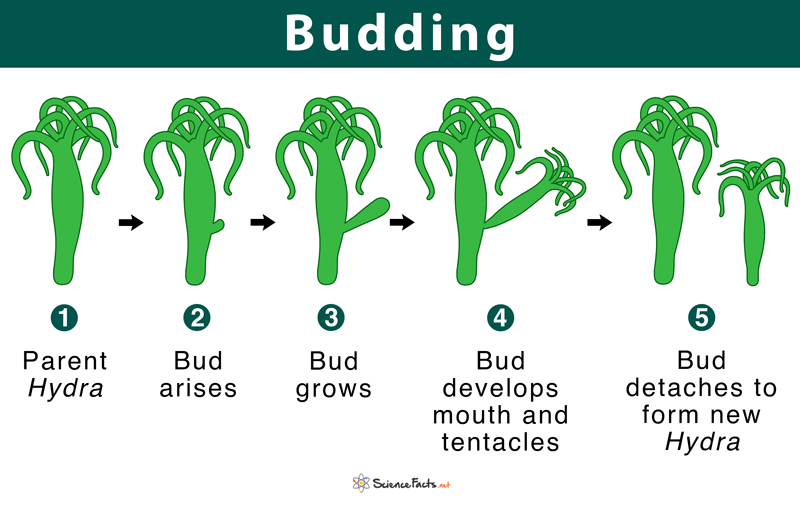Budding
What is Budding
Budding is a mode of asexual reproduction where a new organism develops as an outgrowth from the body of the parent organism. The outgrowth continues to grow in size until it detaches and becomes an independent organism. In certain cells, buds may be produced from almost any part of the body, while in others, budding is limited to specialized areas.
Examples of Organisms That Use the Method
Few unicellular organisms such as bacteria, fungi (e.g., yeast), and protozoa, a number of metazoan animals including certain cnidarian species (e.g., Hydra) and various plants.
What Happens During Budding
Budding in Hydra
- A small bud develops from the parent Hydra, resembling a tiny projection, through repeated mitotic division.
- The developed bud starts to grow in size by receiving nutrients from the parent’s body. Growth starts with the development of the mouth and small tentacles.
- After 2 to 3 days the mature bud gets separated from the parent body and starts functioning as an individual Hydra.
Examples: Hydra vulgaris, Hydra oligactis, Hydra oxycnida, and Hydra Canadensis
Budding in Other Organisms
In Yeasts
- It starts with the softening of a small portion of the parent cell wall, followed by the development of a small protuberance (bud) on one side of the parent body.
- The nuclear division of the parent cell occurs simultaneously so the parent genetic material can be passed to the new bud, along with other cell organelles.
- A narrowing or constriction starts around the site of budding, with the development of a new cell wall or septum. As the ring of constriction grows, the septum starts to grow inwards, thus formation a primary septum and then a secondary septum.
- The formation of the secondary septum is accompanied by the separation of the two cells. Once the new individual yeast cell has separated from the parent cell, the latter can then start another budding cycle once it’s ready.
By repeating this process, budding produces what appear to be a chain of yeast cells under a microscope. At the same time, the parent cell may also start producing a new bud causing it to appear branched.
Examples: Saccharomyces cerevisiae
In Bacteria
Here, a small bud forms at one end of the mother cell or on filaments called prosthecae. With growth, the bud continues to enlarge while the size of the mother cell remains constant. This is followed by DNA replication in the mother cell and their separation into the bud. When the bud is almost the same size as the mother cell, it gets separated to form a new individual.
Examples: Cyanobacteria, Rhodopseudomona, Hyphomicrobium, and Planctomyces
In Plants
In plants, it is a form of vegetative reproduction during which roots or stems of plants give rise to an entire new plant through repetitive division of cells present in those parts. Budding can also be induced artificially by horticulture, a propagation technique commonly known as grafting. Here the bud or scion from one plant is transferred inside the other, allowing both plants to grow together.
Examples: Rose plants; the method is utilized in horticulture to produce new plants in the bud grafting technique.
Advantages and Disadvantages of Budding
Advantages
- A fast process of reproduction
- Only requires a single parent and does not need a mating partner for the reproduction to happen
- Allows good genes of the parent to be passed down to the daughter cell
Disadvantages
- The organisms originated from budding are incapable of adaptation to changes in the environment, and thus are at risk of becoming extinct
- New varieties of organisms with new genetic makeup cannot be developed
Budding vs. Binary Fission
Although similar in some ways, as both are asexual modes of reproduction occurring without the involvement of sex cells or gametes, they do have the following differences.
| Basis | Budding | Binary Fission |
| Definition | A type of vegetative propagation where the new organism develops as an outgrowth from the body of the parent organism | An asexual mode of reproduction where the parent cell divides equally to form two daughter cells |
| Type of Division | Asymmetric division of the parent cell | Symmetric division of the parent cell |
| Fate of the Parent Cell | Both the parent and daughter cells remain intact after division | The parent cells get divided into the daughter cells after division |
| Size of the Daughter Cell | Much smaller than the parent cell | Both daughter cells are of equal size |
-
References
Article was last reviewed on Wednesday, February 1, 2023





great biological contents. thanks